
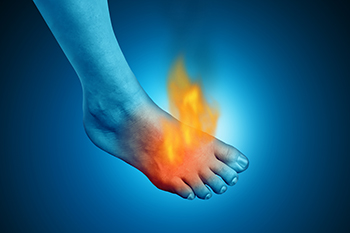
Experiencing a burning sensation in your feet while running can be painful and disrupt your fitness routine. This common issue can arise from overuse of foot muscles, iwearing mproper footwear, and friction. Running on hot surfaces and excessive sweating are other factors for burning feet. Overworking your foot muscles without adequate rest can lead to fatigue and a burning sensation. Friction from poorly fitting shoes or socks can irritate the skin while running on hot surfaces can directly cause a burning feeling. Excessive sweating creates a moist environment that can irritate the skin further. Addressing these issues through wearing proper footwear, moisture-wicking socks, and adequate rest can help alleviate symptoms. However, if the burning persists, it might indicate a more serious underlying condition such as nerve damage, diabetes, or hypothyroidism. If your feet feel like your feet are burning during a run, it is suggested that you schedule an appointment with a podiatrist.
Exercising your feet regularly with the proper foot wear is a great way to prevent injuries. If you have any concerns about your feet, contact Dr. Nooshin Zolfaghari of VIP Foot & Ankle Center. Our doctor will treat your foot and ankle needs.
How to Prevent Running Injuries
Many common running injuries are caused by overuse and overtraining. When the back of the kneecap starts wearing out and starts causing pain in your knee, this is commonly referred to as runner’s knee. Runner’s knee is a decrease in strength in your quadriceps and can occur if you’re not wearing properly fitted or supporting shoes. To prevent runner’s knee, focusing on hip strengthening is a good idea, as well as strengthening your quads to keep the kneecaps aligned.
What Are Some Causes of Running Injuries?
- One cause of a common running injury is called iliotibial band syndrome.
- Plantar fasciitis is also another common injury.
- Stress fractures can occur from overtraining, lack of calcium, or even your running style.
Best Ways to Prevent Running Injuries
- Wear footwear that fits properly and suits your running needs.
- Running shoes are the only protective gear that runners have to safeguard them from injury.
- Make a training schedule. Adding strengthening exercises as well as regular stretching can help keep you strong and limber and can lessen the possibility of injuries.
- Stretching keeps muscles limber; this will help you gain better flexibility.
If you have any questions please feel free to contact our office located in Pembroke Pines, FL . We offer the newest diagnostic and treatment technologies for all your foot and ankle needs.
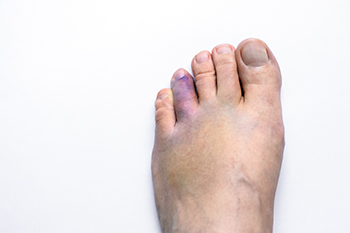
Diagnosing a broken toe involves recognizing symptoms such as intense pain, swelling, bruising, and difficulty walking. Types of toe fractures include stress fractures, where small cracks form from repetitive stress, and traumatic fractures, resulting from a direct blow or impact. A doctor will perform a physical examination and may order X-rays to confirm the diagnosis and determine the fracture type. Relief options for a broken toe include rest and elevation to reduce swelling and pain. Depending on the type of fracture, buddy-taping the injured toe to an adjacent toe may provide support and alignment during healing. Wearing stiff-soled shoes can protect the toe and ease walking. In severe cases, a cast or surgery may be necessary to ensure proper healing. If you have fractured your toe, it is suggested that you consult a podiatrist who can guide you toward a comprehensive treatment plan.
Broken toes may cause a lot of pain and should be treated as soon as possible. If you have any concerns about your feet, contact Dr. Nooshin Zolfaghari from VIP Foot & Ankle Center. Our doctor will treat your foot and ankle needs.
What Is a Broken Toe?
A broken toe occurs when one or more of the toe bones of the foot are broken after an injury. Injuries such as stubbing your toe or dropping a heavy object on it may cause a toe fracture.
Symptoms of a Broken Toe
Although the injured toe should be monitored daily, it is especially important to have a podiatrist look at your toe if you have severe symptoms. Some of these symptoms include worsening or new pain that is not relieved with medication, sores, redness, or open wounds near the toe.
If you have any questions, please feel free to contact our office located in Pembroke Pines, FL . We offer the newest diagnostic and treatment technologies for all your foot care needs.
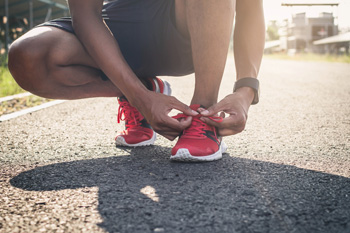
Choosing the right running shoes based on your foot type and running style is critical for comfort and injury prevention. For pronated feet, where the foot rolls inward excessively, stability or motion-control shoes provide the necessary support. Neutral runners, whose feet roll inward slightly, benefit from neutral cushioning shoes that offer balanced support. Supinated feet, which roll outward, require shoes with extra cushioning to absorb impact. Arch level is another consideration. High arches need cushioned shoes for shock absorption, while low arches benefit from stability shoes. Heel strikers, who land on their heels, should look for shoes with ample heel cushioning. Additionally, midfoot and forefoot strikers need shoes with cushioning in the midfoot and forefoot areas. Runners can experience foot injuries from wearing shoes that do not fit their running needs. If this applies to you, it is suggested that you consult a podiatrist who can treat any foot condition, and guide you on how to choose the right running shoes for you.
You should always make sure your running shoes fit properly in order to avoid injury. For more information, contact Dr. Nooshin Zolfaghari from VIP Foot & Ankle Center. Our doctor can provide the care you need to keep you pain-free and on your feet.
Choosing the Right Running Shoe for Your Foot Type
Improper shoe sizing can cause a myriad of problems for your feet. Shoes that don’t fit you properly can lead to muscular imbalances in your body, which can result in foot, knee, and hip injuries.
Tips for Finding the Right Running Shoe
If you have any questions please feel free to contact our our office located in Pembroke Pines, FL . We offer the newest diagnostic and treatment technologies for all your foot and ankle needs.
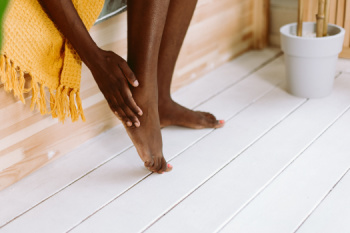 Stretches are essential for maintaining healthy, flexible ankles, which play a pivotal role in overall foot and knee health. Performing ankle stretches can enhance joint mobility, making it easier to perform daily activities and reducing the risk of injuries, particularly during exercise or sports. A variety of effective ankle stretches can be easily incorporated into your routine. For instance, while seated on a chair or floor, you can stretch your ankles by pointing your toes away from and then towards your body, holding each position for about 20 seconds and repeating five to ten times. Another beneficial stretch involves rotating the ankle, which helps to loosen the joint. Additionally, inversion and eversion stretches, where you turn your foot inward and outward, can significantly improve ankle flexibility. Incorporating dynamic movements like jumping and hopping after static stretching further prepares your ankles for more intense physical activity. Stretching the ankle muscles not only helps to prevent injuries but also optimizes performance by enhancing muscle elasticity and power. If you are experiencing ankle pain, it is suggested that you make an appointment with a podiatrist for an exam and treatment.
Stretches are essential for maintaining healthy, flexible ankles, which play a pivotal role in overall foot and knee health. Performing ankle stretches can enhance joint mobility, making it easier to perform daily activities and reducing the risk of injuries, particularly during exercise or sports. A variety of effective ankle stretches can be easily incorporated into your routine. For instance, while seated on a chair or floor, you can stretch your ankles by pointing your toes away from and then towards your body, holding each position for about 20 seconds and repeating five to ten times. Another beneficial stretch involves rotating the ankle, which helps to loosen the joint. Additionally, inversion and eversion stretches, where you turn your foot inward and outward, can significantly improve ankle flexibility. Incorporating dynamic movements like jumping and hopping after static stretching further prepares your ankles for more intense physical activity. Stretching the ankle muscles not only helps to prevent injuries but also optimizes performance by enhancing muscle elasticity and power. If you are experiencing ankle pain, it is suggested that you make an appointment with a podiatrist for an exam and treatment.
Ankle pain can have many different causes and the pain may potentially be serious. If you have ankle pain, consult with Dr. Nooshin Zolfaghari from VIP Foot & Ankle Center. Our doctor will assess your condition and provide you with quality foot and ankle treatment.
Ankle pain is any condition that causes pain in the ankle. Due to the fact that the ankle consists of tendons, muscles, bones, and ligaments, ankle pain can come from a number of different conditions.
Causes
The most common causes of ankle pain include:
Symptoms
Symptoms of ankle injury vary based upon the condition. Pain may include general pain and discomfort, swelling, aching, redness, bruising, burning or stabbing sensations, and/or loss of sensation.
Diagnosis
Due to the wide variety of potential causes of ankle pain, podiatrists will utilize a number of different methods to properly diagnose ankle pain. This can include asking for personal and family medical histories and of any recent injuries. Further diagnosis may include sensation tests, a physical examination, and potentially x-rays or other imaging tests.
Treatment
Just as the range of causes varies widely, so do treatments. Some more common treatments are rest, ice packs, keeping pressure off the foot, orthotics and braces, medication for inflammation and pain, and surgery.
If you have any questions, please feel free to contact our office located in Pembroke Pines, FL . We offer the newest diagnostic and treatment technologies for all your foot care needs.
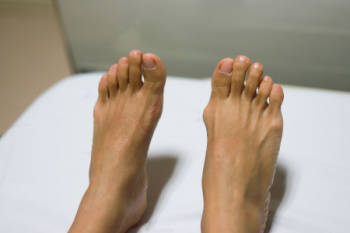 A bunion, medically known as hallux valgus, is a bony bump that forms on the joint at the base of the big toe, causing the toe to deviate toward the others. It occurs due to pressure on the big toe joint, often from wearing tight or ill-fitting shoes, genetics, or foot stress. Bunions can cause pain, swelling, redness, and difficulty in walking. They may also lead to other foot problems such as calluses, corns, and hammertoes. Management options depend on the severity of the bunion and the pain it causes. For mild cases, a wait and see approach can be effective, with changes in footwear to alleviate pressure. Orthotic devices, such as custom shoe inserts, can provide support and relieve pain. When conservative treatments fail and pain or deformity is severe, surgery may be necessary to realign the bone, ligaments, and tendons. If you have a bunion that is causing you discomfort, it is suggested that you schedule an appointment with a podiatrist who can determine what the best treatment approach is for you.
A bunion, medically known as hallux valgus, is a bony bump that forms on the joint at the base of the big toe, causing the toe to deviate toward the others. It occurs due to pressure on the big toe joint, often from wearing tight or ill-fitting shoes, genetics, or foot stress. Bunions can cause pain, swelling, redness, and difficulty in walking. They may also lead to other foot problems such as calluses, corns, and hammertoes. Management options depend on the severity of the bunion and the pain it causes. For mild cases, a wait and see approach can be effective, with changes in footwear to alleviate pressure. Orthotic devices, such as custom shoe inserts, can provide support and relieve pain. When conservative treatments fail and pain or deformity is severe, surgery may be necessary to realign the bone, ligaments, and tendons. If you have a bunion that is causing you discomfort, it is suggested that you schedule an appointment with a podiatrist who can determine what the best treatment approach is for you.
If you are suffering from bunion pain, contact Dr. Nooshin Zolfaghari of VIP Foot & Ankle Center. Our doctor can provide the care you need to keep you pain-free and on your feet.
What Is a Bunion?
Bunions are painful bony bumps that usually develop on the inside of the foot at the joint of the big toe. As the deformity increases over time, it may become painful to walk and wear shoes. Women are more likely to exacerbate existing bunions since they often wear tight, narrow shoes that shift their toes together. Bunion pain can be relieved by wearing wider shoes with enough room for the toes.
Causes
Symptoms
In order to diagnose your bunion, your podiatrist may ask about your medical history, symptoms, and general health. Your doctor might also order an x-ray to take a closer look at your feet. Nonsurgical treatment options include orthotics, padding, icing, changes in footwear, and medication. If nonsurgical treatments don’t alleviate your bunion pain, surgery may be necessary.
If you have any questions, please feel free to contact our office located in Pembroke Pines, FL . We offer the newest diagnostic and treatment technologies for all your foot care needs.